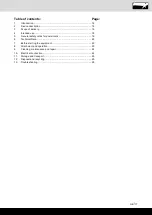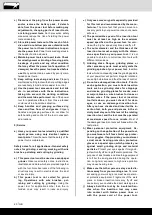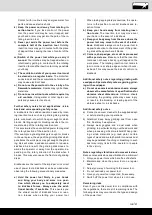
GB | 25
11. Storage and transport
1. Whenever you do not use the power tool, you
must keep it in a dry and well ventilated place out
of the reach of children, e.g. on a high cabinet or
in a closed place.
2. Keep power tool, instruction manual and acces-
sory parts, if any, together in the original pack-
aging, if possible. Thus you have all information
and parts available at any time.
3. Always hold the power tool by its handle.
4. To avoid transport damages, you must pack the
power tool or use the original packaging.
5. Protect the power tool against vibrations and
shock, especially during transport in vehicles.
12. Disposal and recycling
The equipment is supplied in packaging to
prevent it from being damaged in transit.
The raw materials in this packaging can
be reused or recycled. The equipment and
its accessories are made of various types
of material, such as metal and plastic. De-
fective components must be disposed of as special
waste. Ask your dealer or your local council.
Old devices must not be disposed of with house-
hold waste!
This symbol indicates that this product must
not be disposed of together with domestic
waste in compliance with the Directive
(2012/19/EU) pertaining to waste electrical and
electronic equipment (WEEE). This product must be
disposed of at a designated collection point. This can
occur, for example, by handing it in at an authorised
collecting point for the recycling of waste electrical
and electronic equipment. Improper handling of
waste equipment may have negative consequences
for the environment and human health due to poten-
tially hazardous substances that are often contained
in electrical and electronic equipment. By properly
disposing of this product, you are also contributing
to the effective use of natural resources. You can
obtain information on collection points for waste
equipment from your municipal administration, pub-
lic waste disposal authority, an authorised body for
the disposal of waste electrical and electronic equip-
ment or your waste disposal company.
• As the user, you are required to ensure, in consulta-
tion with your electric power company if necessary,
that the connection point at which you wish to oper-
ate the product meets one of the two requirements,
a) or b), named above.
Important information
In the event of an overloading the motor will switch
itself off. After a cool-down period (time varies) the
motor can be switched back on again.
Damaged electrical connection cable.
The insulation on electrical connection cables is of-
ten damaged.
This may have the following causes:
• Passage points, where connection cables are
passed through windows or doors.
• Kinks where the connection cable has been im-
properly fastened or routed.
• Places where the connection cables have been cut
due to being driven over.
• Insulation damage due to being ripped out of the
wall outlet.
• Cracks due to the insulation ageing.
Such damaged electrical connection cables must not
be used and are life-threatening due to the insulation
damage.
Check the electrical connection cables for damage
regularly. Make sure that the connection cable does
not hang on the power network during the inspection.
Electrical connection cables must comply with the
applicable VDE and DIN provisions. Only use con-
nection cables with the marking „H05VV-F“.
The printing of the type designation on the connec-
tion cable is mandatory.
AC motor:
• The mains voltage must be 220-240 - 240 V~.
• Extension cables up to 25 m long must have a
cross-section of 1.5 mm
2
.
Connections and repairs of electrical equipment may
only be carried out by an electrician.
Please provide the following information in the event
of any enquiries:
• Type of current for the motor
• Machine data - type plate
WARNING! There are no parts inside the pow-
er tool which can be serviced by the operator!
Never open the power tool! Take it to a qualified
specialist for further maintenance!
















































